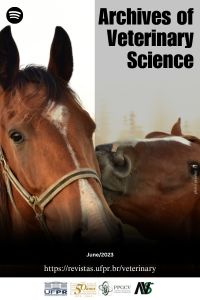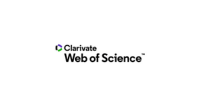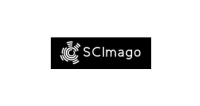Comparison of three commercial enzyme-linked immunosorbent assays for the diagnosis of Classical Swine Fever
DOI:
https://doi.org/10.5380/avs.v28i2.90894Palavras-chave:
Classical swine fever, ELISA, Costa RicaResumo
Classical swine fever (CSF) is a highly contagious viral disease that affects both pigs and wild boars. The disease can cause significant economic losses in the pig industry and poses a threat to food security. Therefore, it is crucial to have effective surveillance programs for detecting and controlling the disease. The aim of this study was to compare three commercial ELISA kits for detecting CSF antibodies. The results showed that all three kits had 100% congruence in undiluted samples, indicating that they are highly reliable for use as a screening test on routine samples. Additionally, the study found good reproducibility between technicians with no significant influence on the variation of results. However, the study also identified a low consistency of positive results (37.7%) for the kit IDvet Screen E2 in diluted samples, with significant variations in results from all three kits. This finding suggests that the other two kits, Herdchek E2 and Priocheck E2, may be better suited for detecting animals with low levels of antibodies, allowing for earlier detection of infected animals and implementation of relevant control measures. In conclusion, the study demonstrates the importance of using high-quality commercial ELISA kits for CSF surveillance. The findings suggest that any of the three kits tested could be used as a reliable screening test on routine samples. However, for detecting animals with low levels of antibodies, the Herdchek E2 and Priocheck E2 kits may be more effective.
Referências
Blome, Sandra, Christoph Staubach, Julia Henke, Jolene Carlson, and Martin Beer. 2017. “Classical Swine Fever—an Updated Review.” Viruses 9 (4): 1–24. https://doi.org/10.3390/v9040086.
Bohórquez, José Alejandro, Sara Muñoz-González, Marta Pérez-Simó, Iván Muñoz, Rosa Rosell, Liani Coronado, Mariano Domingo, and Llilianne Ganges. 2020. “Foetal Immune Response Activation and High Replication Rate during Generation of Classical Swine Fever Congenital Infection.” Pathogens 9 (4): 285. https://doi.org/10.3390/pathogens9040285.
Cabezón, O., A. Colom-Cadena, S. Muñoz-González, M. Pérez-Simó, J. A. Bohórquez, R. Rosell, I. Marco, M. Domingo, S. Lavín, and L. Ganges. 2017. “Post-Natal Persistent Infection With Classical Swine Fever Virus in Wild Boar: A Strategy for Viral Maintenance?” Transboundary and Emerging Diseases 64 (2): 651–55. https://doi.org/10.1111/tbed.12395.
Cabezón, Oscar, Sara Muñoz-González, Andreu Colom-Cadena, Marta Pérez-Simó, Rosa Rosell, Santiago Lavín, Ignasi Marco, et al. 2017. “African Swine Fever Virus Infection in Classical Swine Fever Subclinically Infected Wild Boars.” BMC Veterinary Research 13 (1): 227. https://doi.org/10.1186/s12917-017-1150-0.
Chmura Kraemer, Helena, Vyjeyanthi S. Periyakoil, and Art Noda. 2002. “Kappa Coefficients in Medical Research.” Statistics in Medicine 21 (14): 2109–29. https://doi.org/10.1002/sim.1180.
Colijn, E.O., M. Bloemraad, and G. Wensvoort. 1997. “An Improved ELISA for the Detection of Serum Antibodies Directed against Classical Swine Fever Virus.” Veterinary Microbiology 59 (1): 15–25. https://doi.org/10.1016/S0378-1135(97)00178-8.
Coronado, Liani, Jose Alejandro Bohórquez, Sara Muñoz-González, Lester Josue Perez, Rosa Rosell, Osvaldo Fonseca, Laiyen Delgado, Carmen Laura Perera, Maria Teresa Frías, and Llilianne Ganges. 2019. “Investigation of Chronic and Persistent Classical Swine Fever Infections under Field Conditions and Their Impact on Vaccine Efficacy.” BMC Veterinary Research 15 (1): 247. https://doi.org/10.1186/s12917-019-1982-x.
De, Comunicación, and Costa Rica. n.d. “Comité de Medidas Sanitarias y Fitosanitarias Original: Español declaratoria sobre el reconocimiento del estatus sanitario de Costa Rica como país libre de peste porcina clásica.”
Ganges, Llilianne, Helen R. Crooke, Jose Alejandro Bohórquez, Alexander Postel, Yoshihiro Sakoda, Paul Becher, and Nicolas Ruggli. 2020. “Classical Swine Fever Virus: The Past, Present and Future.” Virus Research 289. https://doi.org/10.1016/j.virusres.2020.198151.
Greiser-Wilke, Irene, Sandra Blome, and Volker Moennig. 2007. “Diagnostic Methods for Detection of Classical Swine Fever Virus—Status Quo and New Developments.” Vaccine 25 (30): 5524–30. https://doi.org/10.1016/j.vaccine.2006.11.043.
Leavens, H., H. Deluyker, A. de Kruif, and D. Berkvens. 1998. “An Experimental Infection with Classical Swine Fever Virus in Weaner Pigs: I. Transmission of the Virus, Course of the Disease, and Antibody Response.” Veterinary Quarterly 20 (2): 41–45. https://doi.org/10.1080/01652176.1998.9694836.
Moser, Christian, Nicolas Ruggli, Jon Duri Tratschin, and Martin A. Hofmann. 1996. “Detection of Antibodies against Classical Swine Fever Virus in Swine Sera by Indirect ELISA Using Recombinant Envelope Glycoprotein E2.” Veterinary Microbiology 51 (1–2): 41–53. https://doi.org/10.1016/0378-1135(96)00019-3.
Muñoz-González, Sara, Nicolas Ruggli, Rosa Rosell, Lester Josué Pérez, Maria Teresa Frías-Leuporeau, Lorenzo Fraile, Maria Montoya, et al. 2015. “Postnatal Persistent Infection with Classical Swine Fever Virus and Its Immunological Implications.” PLOS ONE 10 (5): e0125692. https://doi.org/10.1371/journal.pone.0125692.
“On Community Measures for the Control of Classical Swine Fever (Text with EEA Relevance).” 2001.
Paton, D.J, A McGoldrick, S Belak, C Mittelholzer, F Koenen, H Vanderhallen, M Biagetti, et al. 2000. “Classical Swine Fever Virus: A Ring Test to Evaluate RT-PCR Detection Methods.” Veterinary Microbiology 73 (2–3): 159–74. https://doi.org/10.1016/S0378-1135(00)00142-5.
Petrov, Anja, Ulrike Blohm, Martin Beer, Jana Pietschmann, and Sandra Blome. 2014. “Comparative Analyses of Host Responses upon Infection with Moderately Virulent Classical Swine Fever Virus in Domestic Pigs and Wild Boar.” Virology Journal 11 (1): 1–6. https://doi.org/10.1186/1743-422X-11-134.
Postel, Alexander, Donald B. Smith, and Paul Becher. 2021. “Proposed Update to the Taxonomy of Pestiviruses: Eight Additional Species within the Genus Pestivirus, Family Flaviviridae.” Viruses 13 (8): 1542. https://doi.org/10.3390/v13081542.
Quiros, Ligia. 2002. “Proyecto Regional de Prevención de La Fiebre Porcina Clásica En Centro América, Belice y Panamá (PREFIP).” Heredia, Costa Rica.
Rijn, P. A. van. 2007a. “A Common Neutralizing Epitope on Envelope Glycoprotein E2 of Different Pestiviruses: Implications for Improvement of Vaccines and Diagnostics for Classical Swine Fever (CSF)?” Veterinary Microbiology 125 (1–2): 150–56. https://doi.org/10.1016/j.vetmic.2007.05.001.
Rijn, P.A. van. 2007b. “A Common Neutralizing Epitope on Envelope Glycoprotein E2 of Different Pestiviruses: Implications for Improvement of Vaccines and Diagnostics for Classical Swine Fever (CSF)?” Veterinary Microbiology 125 (1–2): 150–56. https://doi.org/10.1016/j.vetmic.2007.05.001.
Schroeder, S., T. von Rosen, S. Blome, W. Loeffen, A. Haegeman, F. Koenen, and Å Uttenthal. 2012. “Evaluation of Classical Swine Fever Virus Antibody Detection Assays with an Emphasis on the Differentiation of Infected from Vaccinated Animals.” OIE Revue Scientifique et Technique 31 (3): 997–1010. https://doi.org/10.20506/rst.31.3.2173.
Servicio Nacional de Salud Animal, 2009. 2009. “Costa Rica país libre de peste porcina clásica.”
Shevel, Yu. v., and S. A. Nychyk. 2022. “Analysis of the Epizootic Status of Classical Swine Fever in the World for the Period 2000–2009 and 2012–2020.” Scientific Messenger of LNU of Veterinary Medicine and Biotechnologies 24 (107): 88–93. https://doi.org/10.32718/nvlvet10715.
Trajman, A., and R. R. Luiz. 2008. “McNemar χ 2 Test Revisited: Comparing Sensitivity and Specificity of Diagnostic Examinations.” Scandinavian Journal of Clinical and Laboratory Investigation 68 (1): 77–80. https://doi.org/10.1080/00365510701666031.
Wang, Lihua, Rachel Madera, Yuzhen Li, David Scott McVey, Barbara S. Drolet, and Jishu Shi. 2020. “Recent Advances in the Diagnosis of Classical Swine Fever and Future Perspectives.” Pathogens 9 (8): 658. https://doi.org/10.3390/pathogens9080658.
Weesendorp, Eefke, Jantien Backer, Arjan Stegeman, and Willie Loeffen. 2011. “Transmission of Classical Swine Fever Virus Depends on the Clinical Course of Infection Which Is Associated with High and Low Levels of Virus Excretion.” Veterinary Microbiology 147 (3–4): 262–73. https://doi.org/10.1016/j.vetmic.2010.06.032.
Downloads
Publicado
Como Citar
Edição
Seção
Licença
Autores que publicam nesta revista concordam com os seguintes termos:
- Autores mantém os direitos autorais e concedem à revista o direito de primeira publicação, com o trabalho simultaneamente licenciado sob a Creative Commons - Atribuição 4.0 Internacional que permite o compartilhamento do trabalho com reconhecimento da autoria e publicação inicial nesta revista.
- Autores têm autorização para assumir contratos adicionais separadamente, para distribuição não-exclusiva da versão do trabalho publicada nesta revista (ex.: publicar em repositório institucional ou como capítulo de livro), com reconhecimento de autoria e publicação inicial nesta revista.
- Autores têm permissão e são estimulados a publicar e distribuir seu trabalho online (ex.: em repositórios institucionais ou na sua página pessoal) a qualquer ponto antes ou durante o processo editorial, já que isso pode gerar alterações produtivas, bem como aumentar o impacto e a citação do trabalho publicado.














